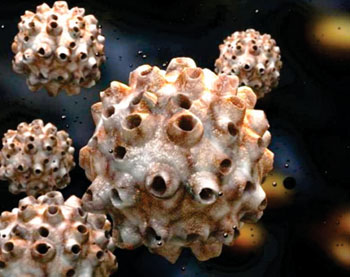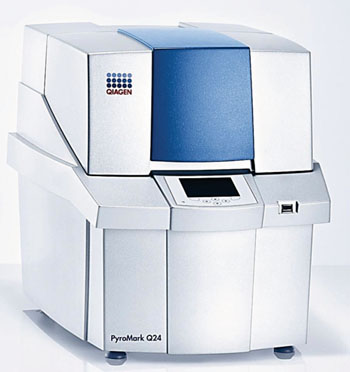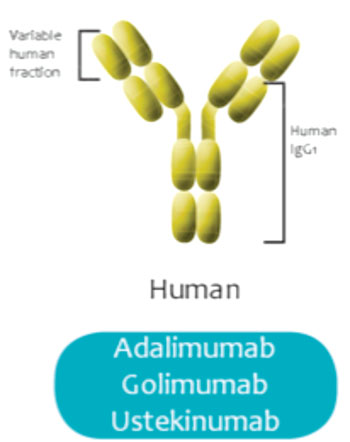Molecular Diagnostics
![Image: Eggs of Schistosoma mansoni in an unstained wet mount (Photo courtesy of the CDC – [US] Centers of Disease Control and Prevention). Image: Eggs of Schistosoma mansoni in an unstained wet mount (Photo courtesy of the CDC – [US] Centers of Disease Control and Prevention).](https://globetechcdn.com/mobile_labmedica/images/stories/articles/article_images/2015-08-12/RLJ-261a.jpg)
Microscopy and Molecular Assay Compared for Schistosomiasis Diagnosis
The current reference test for the detection of Schistosoma mansoni in endemic areas is stool microscopy based on one or more Kato-Katz stool smears, but this technique is highly observer-dependent and has suboptimal sensitivity. More...12 Aug 2015

HPV16 in Oral Rinses Predicts Prognosis in Oropharyngeal Cancer
The presence of persistent human papillomavirus type 16 DNA in oral rinses after treatment for HPV-related oropharyngeal cancer is rare, but it appears to be associated with poor prognosis and therefore may have potential as a long-term tool for tumor surveillance. More...12 Aug 2015

![Image: Highly-magnified, digitally-colorized transmission electron micrograph (TEM) of a number of red-colored, spherical-shaped Middle East Respiratory Syndrome Coronavirus (MERS-CoV) virions (Photo courtesy of NIAID – [US] National Institute of Allergy and Infectious Diseases). Image: Highly-magnified, digitally-colorized transmission electron micrograph (TEM) of a number of red-colored, spherical-shaped Middle East Respiratory Syndrome Coronavirus (MERS-CoV) virions (Photo courtesy of NIAID – [US] National Institute of Allergy and Infectious Diseases).](https://globetechcdn.com/mobile_labmedica/images/stories/articles/article_images/2015-08-10/RLJ-249.jpg)

CE Marking of Theranostic Monitoring Test Announced at 2015 AACC Annual Meeting
A company specializing in theranostics and in vitro diagnostics took advantage of the 2015 AACC Annual Meeting & Clinical Lab Expo venue to announce that it had obtained CE marking for its monitoring test for levels of the monoclonal antibody drug ustekinumab. More...10 Aug 2015
![Image: Human pap smear showing H&E stained Chlamydia in the vacuoles (500x) (Photo courtesy of the [US] National Cancer Institute). Image: Human pap smear showing H&E stained Chlamydia in the vacuoles (500x) (Photo courtesy of the [US] National Cancer Institute).](https://globetechcdn.com/mobile_labmedica/images/stories/articles/article_images/2015-07-29/GMS-250.jpg)
Low Cost Point-of-Care DNA Amplification Test for Chlamydia Infection Demonstrated at the 2015 AACC Annual Meeting
Researchers have demonstrated a low cost, point-of-care nucleic acid amplification testing platform that meshes with a smartphone application for rapid diagnosis of Chlamydia infection at the 2015 AACC Annual Meeting & Clinical Lab Expo. More...10 Aug 2015

In Other News
Genetic Mutation Causes Lethal Condition in Infants
Advanced Next-Generation Sequencing Assay Kit Now Available for the Diagnosis of Leukodystrophy
Genomic Assays Identify Chikungunya Virus in Blood Donors
Prenatal Testing May Also Detect Some Maternal Cancers
Blood Test Could Identify Diabetes Decades Before It Develops
Consensus Guidelines for Thyroid Cancer Molecular Tests Revised
Genomic Aberrations of Asian Gastric Cancer Discovered
New Test Helps Predict Prognosis in Multiple Myeloma
Sensitive Technique Detects Colorectal Cancer in Tissue Samples
Blood Test Biomarker Differentiates Early Stage Pancreatic Cancer
Massively Parallel Gene Function Assays Reduce Genetic Diagnoses Ambiguity
Multiple Genetic Changes Linked to Increased Pancreatic Cancer Risk
Gene Mutation Identified That Can Trigger Lymphoblastic Leukemia
Overexpression of X Chromosome Genes Is Biomarker for Female Mental Disorders
Efficient Molecular Method Detects Pathogenic Leptospires
Biomarkers Help Personalize Metastatic Colorectal Cancer Treatment
Gene Mutations Leave Patients Vulnerable to Severe Early Infections
Molecular Classification Improves Method to Diagnose Gliomas
Utility and Performance of Heart Transplant Test Confirmed
New Genetic Variants Identified for Bloom Syndrome
Prognostic Marker Gene Found for Anaplastic Astrocytoma
Early-Stage Cancers May Be Detected with Noninvasive Prenatal Testing
Endoscopic Samples Show Precancerous Genomic Changes in Barrett's Esophagus
Genetic Testing channel of LabMedica brings the latest in molecular genetics, cytogenetics, and epigenetics, and methods from PCR to FISH, and more.











